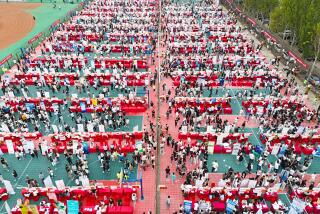China once struggled to feed its people. Now it’s seeing a rise in eating disorders
The patients filed into a drab, gray-paneled room, clothes hanging from skeletal frames. One young woman held a plastic bag of cookies. Visitors looked up at the hospital’s faded Chinese New Year decorations and pretended not to notice their entrance.
A mother stood in front of the packed room and described how doctors labeled her daughter’s eating disorder a digestive ailment. A teenager said she was on her fourth stay at the hospital and hoped to stop vomiting after every dinner. A woman begged for help with a child whose bones showed through her skin.
This is the dark side of China’s rising affluence. The support session at a Peking University hospital, one of only a handful with services dedicated to eating disorders, offers a glimpse into an illness nearly unheard of 30 years ago — a complex byproduct of modernization and media.
Treatment options have not kept pace with the disorder, often misdiagnosed and shrouded in stigma. In a country where “Have you eaten?” is a common greeting, experts struggle to understand the life-threatening ailment and determine how a stretched mental health system can ensure adequate care.
“People think if someone is skinny, it means that she is very successful,” said Ning Yaxian, who at 14 started suffering from a self-starvation syndrome commonly known as anorexia. She would make up for it by compulsive binge eating and guilt-induced purging, often associated with bulimia. It gave her a sense of control.
Yaxian’s parents, both doctors in the vibrant southern city of Shenzhen, couldn’t figure out what was wrong. Her grades dropped. She left school.
“The eating disorder patient in China is much more common than people think,” said Yaxian, now 17 and about to repeat her senior year of high school. “It’s very dangerous but no one is stopping them.”
Doctors can’t pinpoint what exactly causes eating disorders. They disagree how much Hollywood and Western influences dictate these behaviors, as opposed to broader effects of industrialization and shifting expectations for women.
When you tell people you have disabilities, you get understanding. But say eating disorder and they say, ‘What?’
— He Ye, the screen name of a 27-year-old from Hunan Province
Changes in what is considered an ideal body type, “some of which are coming from the West, are influencing where China is now,” said Kathleen Pike, executive director of the Global Mental Health Program at Columbia University. “But China has its own set of dynamics occurring that results in increasing risk.”
Whereas images of robust, working-class women once signaled achievement, narrow chins and concave waists now do. Diets and plastic surgery are popular; so are laxatives and thinness competitions. This spring, scores of women posted photos on Chinese social media to prove their waists did not protrude from behind a vertical 8.3 x 11.7 inch piece of paper. People’s Daily, the Communist Party’s flagship paper, called it a “fitness challenge.”
Add to this the intense pressure that only children, the legacy of China’s one-child policy, often feel to achieve.
“Are there enough treatment centers? Of course not,” said Li Xueni, director of the Eating Disorder Center’s inpatient unit at Peking University Sixth Hospital, which opened the country’s only closed ward for eating disorders five years ago. “Often after visiting, doctors come to the conclusion that they don’t have the necessary resources to establish another facility at their hospital.”
The new unit, on a locked floor colored in pale blue, treated about 250 patients last year. That’s 10 times the number the entire psychiatric ward assisted just over a decade ago.
The Shanghai Mental Health Center has witnessed its greatest uptick in the past five years. The outpatient clinic last year received nearly 1,000 eating disorder-related visits.
Officials have yet to conduct a widespread investigation, which means the disorders’ true impact remains unknown. A 2013 study among female college students in the central Chinese city of Wuhan, considered one of the best estimates of national rates, found levels comparable to Western countries.
Japan started to document eating disorders in the 1960s, the first Asian country to do so. By the 1990s, cases were popping up in South Korea, Singapore and Hong Kong. Patients didn’t always link their behavior to a fear of getting fat, but started to when knowledge of the disease spread.
Demand for mental-health care has grown overall in China, as citizens deal with modern-day anxieties and rates of diagnosis increase. The country in 2012 passed its first mental-health law, and will soon confront issues of an aging society, in particular dementia. Exploding obesity levels also have overshadowed the uptick in eating disorders, which occur more often in young women.
Officials have poured resources into tackling the more visible epidemic of excessive weight gain. But Chinese society still largely views the opposite problem as a personal weakness, something to handle quietly if it is addressed at all.
He Yi recognized the sounds that followed meals in her college dorm, a retching and gagging from the bathroom stall next door. She wasn’t the only one who was regularly purging.
“I lost weight as a way to obliterate my frustrations,” said the 27-year-old native of Hunan, a mountainous southern province, who asked to use her screen name to avoid attention. “What I was looking for was some sense of wholeness.”
When she finally told her mother, she took it as a public indictment of her parenting. He Yi now runs an online eating-disorder information group with about 12,000 subscribers, and just went to the U.S. to study clinical social work.
“When you tell people you have disabilities, you get understanding,” she said. “But say ‘eating disorder’ and they say, ‘What?’”
China has a tangled history with body shape. For centuries, the country prioritized delicate features and bone-crushing foot binding. But the Tang Dynasty favored larger body types. One of its most revered beauties, Yang Guifei, had stomach rolls.
And few focused on body image in the early 1960s, when Chinese leader Mao Tse-tung’s failed attempt to industrialize the country led to widespread starvation. Older generations equate eating with well-being.
“Society’s pursuit of a certain body type or facial feature style is harming the youth a lot,” said Zhang Darong, a medical professor at Peking University and one of the country’s foremost experts on eating disorders. “It’s not necessarily a determining factor, but it’s definitely a contributing factor.”
She also links the spread of the disease to “the culture of personal success.”
Zhang assists at a new, upscale private hospital in northwest Beijing, near the shady repose of the Fragrant Hills imperial garden. Massage chairs, a fitness center and coffee bar give the aura of a luxury hotel. Beijing Yining Hospital caters to a clientele willing to pay for quality mental-health services — not least of them eating disorders.
When she started focusing on the issue in the 1980s, foreign experts would question whether eating disorders even existed in China, Zhang said. “They believed it was a Western condition, that Chinese are so thin to begin with.”
They no longer ask.
Meyers is a special correspondent.
ALSO
Op-Ed: Liberia must learn to honor the rights of rural residents to manage their own land
More than a year after the nuclear deal, Iranians are still waiting for an economic revival
The war in Syria was already complicated. Now a border skirmish is adding a new level of intrigue
More to Read
Start your day right
Sign up for Essential California for news, features and recommendations from the L.A. Times and beyond in your inbox six days a week.
You may occasionally receive promotional content from the Los Angeles Times.






